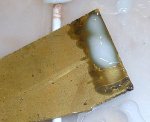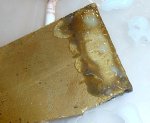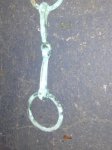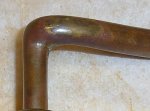N
Nomad
Guest
I'm developing an interest in adding patina to brass for a couple of reasons. One is to make a new belt with a non-shiny buckle, and I had ordered a couple of buckles from LePrevo when I had ordered leather a while back. I decided to have a go with a buckle held over a bath of vinegar and salt to see what happened - and nothing happened. It turned out that the LePrevo buckles are lacquered, which was confirmed when I tried to measure resistance using a multimeter - got an open circuit, telling me the surface had an insulator on it. I tried wiping it with Acetone to no avail.
I did a bit of mooching around and ended up choosing B&Q's own-brand Diall paint and varnish remover (which I had seen working well in some YouTube vids, where someone restores toy cars). A small dollop of this was put into a plastic box and a cheapie small brush used to paint it over the buckle. After a couple of hours, I thought I could see some bits of the brass darkening in places, but wasn't sure if it was just the clear lacquer discolouring, so I left it in overnight, then flipped it over and left it another night. I just took it out of the box and gave it a scrub in some warm soapy water.
Here's what I used...

Cheapie plastic boxes from Tesco (3 for £2), and even cheaper toothbrushes from Morrisons (2-pack for a mere 30p!), and 500ml of Diall stripper at £3.80.
Here's a before and after...

Untreated buckle on the left. The dark bits are reflections - it's all clean, shiny brass when you wiggle it about in the light.
A closer view...
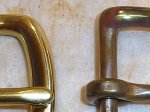
The patina has exactly the sort of old, antique look I was after, even though I wasn't expecting it. There are a couple of small spots that are still shiny (perhaps missed when slapping the stuff on), but these seem to be more conductive than the untreated buckle, albeit still needing a little pressure from the meter probes. The areas with the patina readily show a short circuit (so it's not a coating of discoloured lacquer).
I've added a little bit of the stripper darken the shiny bits...
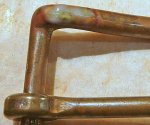
I'm really pleased with this unexpected result - saves having to experiment with various chemicals to try and get the dark brown style of patina (which I think involves using Sulphur in some form).
I still need to see if there's a time period where lacquer or paint can be removed without adding patina (I have a brass thing that I want to remove paint from, but want the option to choose whether, or how much, patina to add). Also want to see if it takes less time to get a nice antique look like the above using the Diall stripper. Another thing I want to do is see if I can get a verdigris type of patina that's robust and stable, rather than the crusty structure that seems to be quite common.
I did a bit of mooching around and ended up choosing B&Q's own-brand Diall paint and varnish remover (which I had seen working well in some YouTube vids, where someone restores toy cars). A small dollop of this was put into a plastic box and a cheapie small brush used to paint it over the buckle. After a couple of hours, I thought I could see some bits of the brass darkening in places, but wasn't sure if it was just the clear lacquer discolouring, so I left it in overnight, then flipped it over and left it another night. I just took it out of the box and gave it a scrub in some warm soapy water.
Here's what I used...

Cheapie plastic boxes from Tesco (3 for £2), and even cheaper toothbrushes from Morrisons (2-pack for a mere 30p!), and 500ml of Diall stripper at £3.80.
Here's a before and after...

Untreated buckle on the left. The dark bits are reflections - it's all clean, shiny brass when you wiggle it about in the light.
A closer view...

The patina has exactly the sort of old, antique look I was after, even though I wasn't expecting it. There are a couple of small spots that are still shiny (perhaps missed when slapping the stuff on), but these seem to be more conductive than the untreated buckle, albeit still needing a little pressure from the meter probes. The areas with the patina readily show a short circuit (so it's not a coating of discoloured lacquer).
I've added a little bit of the stripper darken the shiny bits...

I'm really pleased with this unexpected result - saves having to experiment with various chemicals to try and get the dark brown style of patina (which I think involves using Sulphur in some form).
I still need to see if there's a time period where lacquer or paint can be removed without adding patina (I have a brass thing that I want to remove paint from, but want the option to choose whether, or how much, patina to add). Also want to see if it takes less time to get a nice antique look like the above using the Diall stripper. Another thing I want to do is see if I can get a verdigris type of patina that's robust and stable, rather than the crusty structure that seems to be quite common.

